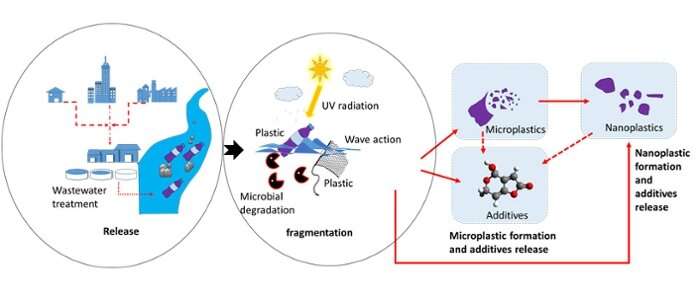Chasing nanoplastics

How dangerous are micro- and nanoplastics? Do they affect the environment? What harm can they do to our bodies? Questions that we can now finally answer because of Fazel Abdolahpur Monikh. Together with his colleagues, he developed a method to detect and quantify nano-sized plastics. Their paper has been published in the journal Environmental Pollution.
A plastic world
A short look around our house or office illustrates that plastics have become an essential part of our lives. Plastic is a great material to work with because it is durable and strong. But thanks to these properties plastic also degrades really badly. In fact, when plastics enter the environment, most of them will only be fragmented into smaller and smaller pieces. Eventually, these pieces become so small that we cannot trace them anymore. What will finally happen to such small pieces of plastic? So far, we haven't been able to answer these questions, because there were no sufficient methods and techniques. Together with the Biologics Formulation Group at the Division of Drug Delivery Technology Leiden, Fazel Abdolahpur Monikh from the Institute of Environmental Sciences now developed the first method ever to quantify and characterise nanoplastics in nature.
Hard to find
"Micro- and nanoplastics are carbon-based materials," explains Abdolahpur Monikh. "Many existing analytical techniques have limitations in dealing with these plastics in physiological media such as blood and tissues, which also contain carbon compounds themselves. Due to the low mass detection limits of the existing techniques, those minuscule plastics are very hard to detect." The new method uses acid digestion, alkali digestion, ultracentrifugation and stabilisers to extract the particles from biological samples. This way the properties of the particles are minimally affected. The new method then uses multiangle light scattering and a special separation technique to determine the size distribution of the extracted particles.
Gaining control
"Our method opens a new horizon for researchers and stakeholders to understand the fate of nanoplastics in the environment and in the bodies of humans and other organisms," Abdolahpur Monikh says. "We can now trace nanoplastics in consumer products, food and the human body. I hope it can help to gain control over the plastic fragments all around us.
Abdolahpur Monikh and his colleagues are currently applying for an ERC Starting Grant and NWO Veni grant to further develop the method and to couple it with other modern techniques. "We want to make a breakthrough in plastic pollution research by finally answering the questions: what is the final destination of our plastic trash, where do they disappear to? And even more important: how do they change the ecosystem functions along the way to their grave?"
Nanoplastics
Nanoparticles are particles between one and 1000 nm in size. Because of this small size, they can have very specific properties, which are different from the properties of comparable particles of a larger size. Through food or drinking water, the particles can enter our body.
Nanoplastics are potentially more harmful than their larger counterparts such as microplastics. Abdolahpur Monikh: "Due to their very small particle size, nanoplastics can easily pass biological barriers such as the gut-blood and blood-brain barrier." The hazard of nanoplastics is also associated with co-occurring contaminants that absorb or adsorb to the plastics from their surrounding environment.
More information: Fazel Abdolahpur Monikh et al. Development of methods for extraction and analytical characterization of carbon-based nanomaterials (nanoplastics and carbon nanotubes) in biological and environmental matrices by asymmetrical flow field-flow fractionation, Environmental Pollution (2019). DOI: 10.1016/j.envpol.2019.113304
Journal information: Environmental Pollution
Provided by Leiden University





















